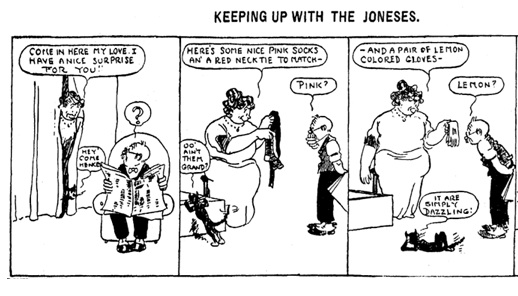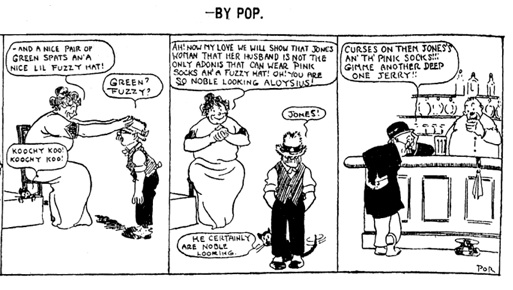Pitting neighbors against one another isn’t always a bad thing...is it?
Hear the companion radio feature to this post on KQED’s The California Report.
 “Keeping Up With the Joneses,” the 1920s-era comic strip that inspired the catch-phrase of the same name, is a classic reminder of the ridiculous lengths we sometimes go to just to impress our neighbors. The need to “keep up” has driven plenty of neighborhoods into frenzies of conspicuous consumption—fueling spending sprees on everything from pink socks and fur-lined miniskirts, to microwaves and McMansions. But can that same impulse really inspire a trend in “non-consumption?”
“Keeping Up With the Joneses,” the 1920s-era comic strip that inspired the catch-phrase of the same name, is a classic reminder of the ridiculous lengths we sometimes go to just to impress our neighbors. The need to “keep up” has driven plenty of neighborhoods into frenzies of conspicuous consumption—fueling spending sprees on everything from pink socks and fur-lined miniskirts, to microwaves and McMansions. But can that same impulse really inspire a trend in “non-consumption?”
According to a growing body of research [PDF download] by environmental economists and behavioral psychologists, the answer is a resounding: Yes! Here are some of interesting nuggets to come out of that research.
How Much Energy Do You Really Save?
Hunt Allcott, an economist at New York University has studied the results of efficiency campaigns that appeal to what the experts call “social norms.” He looked at Opower, a company that has partnered with dozens of energy utilities across the country to send customers “home energy report cards” that let people know how their energy use compares to their neighbors. According to his calculations, households receiving these reports lower their overall energy consumption by 2% on average.
“While that may not sound like a lot” Allcott says, it’s a lot of bang for less than a buck. (Make that 60 cents, which is about how much it costs utility companies to send out these reports every few months, though Opower won’t disclose the exact price.) “It ends up being an especially cost-effective approach for utilities” Allcott says, many of which are now are now legally required to take steps to help their customers save energy.
Inspiring people to save energy with a little neighborly competition may also be a more politically palatable approach, than, say, jacking up prices to get customers to cut back on their energy consumption. Allcott estimates you’d have to raise energy prices by 10% to get the kind of energy savings that these home energy reports have sparked.
If You Do Your Part, I’ll Do Mine
The idea that social comparisons would spur people to consume less energy goes against conventional economic wisdom, according to economist Paul Ferraro at Georgia State University, who studies efficiency strategies that play on social norms. “If you look at any typical economic textbook that characterizes human behavior it tends to focus on private benefits,” Ferraro says. “We act for our own selfish good. We care about profits. We care about our own satisfaction.” Using that logic, the idea that we’d start being more energy efficient just to keep up with our neighbors doesn’t make sense.
One theory about what’s going on here is something called “conditional cooperation.” As NYU’s Allcott explains, even if you care about climate change, one of the things that’s especially challenging is that it feels like it’s such a big global, daunting problem. “We feel like if I do something it’s not really going to have an impact—there are so many people out there that are not doing anything.” Allcott says one of the nice things about social comparisons “is that you help people to see that we’re all part of a group and if we all conserve together that actually will have a big impact.”
The Risks of Conspicuous Non-consumption
Reducing your energy footprint to keep up with your neighbors may not always lead to the most efficient outcomes, warns Ferraro. “If it’s about how others perceive me, then I might take actions that might not be the most cost-effective, but are the most visible to my neighbors.” Instead of, for example, improving the insulation in your attic to reduce your electricity use, Ferraro says “I might instead install solar panels on my roof where everybody can see that I’m doing something for the environment.” Even if that’s not the most cost-effective way for you to reduce their energy use.
2 thoughts on “War of Watts: Neighbors Compete for Lowest Energy Use”
Comments are closed.




Compared with the average OPower reduction of 2% Simple Energy showed over 20% reduction in energy use, with the winner of the program achieving an almost 50% reduction – now that’s some serious savings! http://utilities.simpleenergy.com/san-diego-gas-and-electric-celebrates-biggest-energy-savers
http://lowfoot.com is another service that operates in California, Texas and Ontario, Canada. Users can sign up, authorize Lowfoot to access their smart meter data. Users are then provided with an energy budget which is 10% below their normal use.
Each day users are sent a notification that shows them how they did up against their budget. Users can share their notifications on Facebook and Twitter and that’s when the competition begins between friends.
Lowfoot pay’s cash money for people to met their goals. They share their ad revenue with users who make their energy budet.
What’s different about Lowfoot? They have no association with the utilities they support. They operate independently from the utilities.